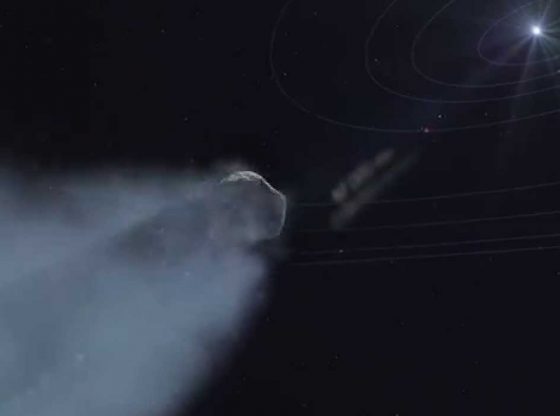An asteroid is speeding through our solar system. It is the first time that researchers have registered such an object on a visit from beyond the solar system.

First detected on October the 19th by the telescope Pan-STARRS in Hawaii, a small flash of light reflecting off an unknown asteroid (possibly a comet).
On closer examination and calculations of the object’s direction of motion show that the 400 meters wide stone has made the journey from beyond our solar system.
The A / 2017 U1 object is thus the first observed asteroid on an interstellar trip from another solar system. The scientists do not know if the object is an asteroid (made up of metals and rocky material) or a comet (made up of ice, dust and rocky material).
Most asteroids in our solar system orbit our sun within the so-called asteroid belt between Jupiter and Mars. But by measuring the A/2017 U1 so-called eccentricity, researchers could see that this particular asteroid’s origin is a place beyond our solar system.
“We have long suspected that these objects should exist, because during the process of planet formation a lot of material should be ejected from planetary systems. What’s most surprising is that we’ve never seen interstellar objects pass through before,”
– Karen Meech, an astronomer at the at the University of Hawaii Institute for Astronomy, specializing in small bodies and their connection to solar system formation.
The eccentricity describes the circular path of the celestial body. If the eccentricity is 0, the object has a perfectly circular path, whereas objects with an eccentricity closer to 1 move in an elongated ellipse.

This asteroid has an eccentricity of just under 1.2 and the trajectory is very straight, which is not characteristic for an asteroid in orbit around the sun. The researchers, therefore, assumes that the A/2017 U1 origins from interstellar space.
“We have been waiting for this day for decades,”
“It’s long been theorized that such objects exist — asteroids or comets moving around between the stars and occasionally passing through our solar system — but this is the first such detection. So far, everything indicates this is likely an interstellar object, but more data would help to confirm it.”
– Paul Chodas at NASA’s Center for Near-Earth Object Studies.
According to NASA’s calculations, A/2017 U1 came in the direction of the constellation Lyran. The object flew at an exceptionally high speed of 25.5 km/s through the solar system and passed the Earth at a distance of 24 million kilometers.
The immense gravity of the sun influenced the asteroid to slingshot past in a curved trajectory with it now heading for the constellation Pegasus, out of the solar system.
Reference:
NASA: Small Asteroid or Comet ‘Visits’ from Beyond the Solar System











![OpenAI. (2025). ChatGPT [Large language model]. https://chatgpt.com](https://www.illustratedcuriosity.com/files/media/55136/b1b0b614-5b72-486c-901d-ff244549d67a-350x260.webp)
![OpenAI. (2025). ChatGPT [Large language model]. https://chatgpt.com](https://www.illustratedcuriosity.com/files/media/55124/79bc18fa-f616-4951-856f-cc724ad5d497-350x260.webp)
![OpenAI. (2025). ChatGPT [Large language model]. https://chatgpt.com](https://www.illustratedcuriosity.com/files/media/55099/2638a982-b4de-4913-8a1c-1479df352bf3-350x260.webp)








